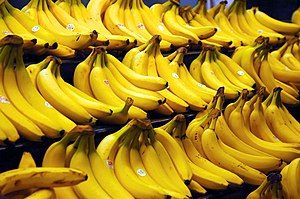Cookbook:Banana
| Banana | |
|---|---|
 | |
| Category | Fruits |
Cookbook | Recipes | Ingredients | Equipment | Techniques | Cookbook Disambiguation Pages | Ingredients | Fruit
The banana is a mildly sweet tropical fruit related to the starchy plantain.
Characteristics
[edit | edit source]Bananas are crescent shaped and 7–9 inches long, with a thick yellow peel and pale yellow flesh. The peel is not edible and can be easily removed by pinching the tip and pulling it off in strips.[1]
Bananas are always picked green.[2][1] When green, they have a high starch content, firmer texture, and a "green" taste somewhat like kiwifruit.[1] As bananas ripen, the starch is converted to sugar,[1] and the peel turns yellow before developing brown spots that eventually merge to make the banana completely dark brown. When fully ripe, a banana should have no green at the tip; once it gets too brown and squishy, it has passed into overripe.[2]
Nutrition and diet
[edit | edit source]Bananas are a nutrient-dense food. They are relatively high in calories, and a medium-sized banana has about 110 calories (460 kilojoules). They also provide potassium calcium, carotene, vitamin C, and vitamin B6. The banana helps prevent both constipation and diarrhea.
Other
[edit | edit source]Bananas are very easy to bruise, which will make them brown and mushy on the inside. Banana ripening produces ethylene gas, so most types of fruit will also ripen when placed in a bag with ripening bananas.[3]
Varieties
[edit | edit source]"Baby" bananas are small, compact bananas with dense and particularly sweet flesh.[1]
Seasonality
[edit | edit source]| Seasonality tables | Autumn | Winter | Spring | Summer | All year | ||||||||||||
|---|---|---|---|---|---|---|---|---|---|---|---|---|
| Banana | Jan | Feb | Mar | Apr | May | Jun | Jul | Aug | Sep | Oct | Nov | Dec |
| Northern hemisphere | ||||||||||||
| Southern hemisphere | ||||||||||||
Bananas are a typical non-seasonal fruit, which means they are available fresh all year. They are usually grown in tropical countries.
Selection and storage
[edit | edit source]In general, bananas should be purchased when underripe and allowed to ripen at room temperature until they reach the desired stage.[1]
When stored at room temperature, bananas will progress through the ripening process, eventually turning completely brown. To store bananas long-term, they may be frozen either in the peel or peeled in an airtight bag/container. Note that when frozen, the banana peel will turn dark brown but the inside will remain unaffected. Avoid refrigerating bananas.[2]
Use
[edit | edit source]Bananas may be eaten plain or used in cooking. A banana is generally best from immediately after the spots appear until the spots begin to merge, but this is a matter of personal preference and application. Firm is better for eating out of hand or in fresh fruit recipes, while the softer and riper stage is generally better for baking.[1] Frozen bananas can be coated in chocolate and eaten as a treat. Green bananas can be used as a vegetable and cooked by boiling or frying. Dried banana chips are often available—choose brown ones (without sulfur dioxide) if you can find them.
If substitution is desired, use pawpaws instead of bananas.
Recipes
[edit | edit source]References
[edit | edit source]- ↑ a b c d e f g Labensky, Sarah R.; Hause, Alan M.; Martel, Priscilla (2018-01-18). On Cooking: A Textbook of Culinary Fundamentals. Pearson. ISBN 978-0-13-444190-0.
- ↑ a b c Gisslen, Wayne (2015-03-12). Essentials of Professional Cooking, 2nd Edition. Wiley Global Education. ISBN 978-1-119-03072-0.
- ↑ Farrimond, Stuart (2017-09-19). The Science of Cooking: Every question answered to perfect your cooking. Penguin. ISBN 978-1-4654-7079-9.